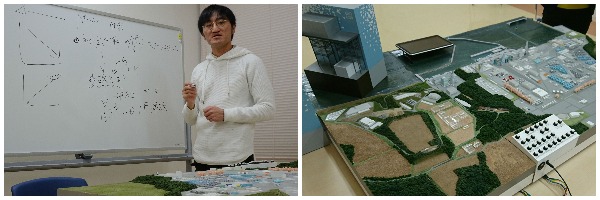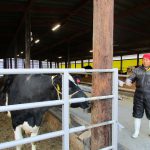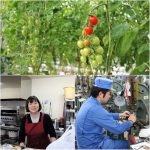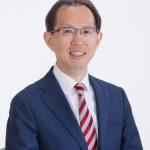Date : February 26 - 27, 2020
Notice: Fukushima Press Tour
post date : 2020.02.07
Hope Tourism
Educational Journeys to See the Real Fukushima (the Light and Darkness) of Fukushima and Speak with People Working on Recovery, Focusing on Stories of Recovery from a World-First Complex Disaster
Population decline, aging populations, divided communities, energy issues. These issues which will likely be faced not only by Japan, but by countries and regions around the world in the future, arose in Fukushima Prefecture all at once with the Great East Japan earthquake and nuclear accident. Having experienced this unprecedented disaster and while facing numerous difficult issues, efforts are being made to deal with these issues not as “problems for just Fukushima,” but as issues that Japanese society as a whole should approach.
This tour will visit Fukushima Prefecture, nine years after the Great East Japan earthquake and TEPCO (Tokyo Electric Power Company) Fukushima Daiichi Nuclear Power Plant accident, and cover efforts to restore communities and the agricultural industry while providing seniors and people with disabilities a place to participate, a school working to provide globally competitive education using the experience of the earthquake and nuclear accident, and initiatives to continue to provide information from the perspective of residents.
【Tour Details】
Wednesday, February 26
1. Hope Tourism: A New Educational Journey of Learning Which Can Only Possible in Fukushima, Which Experienced a World-First Complex Disaster
Fukushima Prefecture, the only place in the world to have experienced an earthquake, tsunami, and nuclear accident all at once, is now engaging in Hope Tourism, with the belief, “There are things which can only be learned in Fukushima.” A single tour will have participants see the real Fukushima (its light and darkness), speak with Fukushima residents working towards recovery, and think as something that personally affects them about how to apply the lessons from the earthquake and nuclear accident to the future. Tours are planned not only for junior high and high school students, but also businesses, individuals, foreign exchange students and foreign tourists, with the number of participants increasing yearly. For this year, the fourth year of the program, there are approximately 50 tours planned.
This tour will cover leaders of the recovery in various districts who are part of the Hope Tourism program, including a former TEPCO employee, a community building organization, residents, educators, and a group creating job opportunities for seniors and people with disabilities in an effort to revive the agricultural industry.
The tour will hear from the Fukushima Prefecture Tourism Section about Hope Tourism, and learn about this initiative to create a new educational program based in Fukushima.
2. Futaba Information Center: A New Type of Recovery Crossing Municipal Boundaries and a Center for Information from the Perspective of Residents (Tomioka)
In April 2017, the evacuation order was lifted for most of Tomioka, a town in Futaba-gun. Mr. Tsutomu Hirayama, a hotel operator in Tomioka, received attention in August 2011 when he put up a banner reading “Tomioka will not lose!” on a pedestrian bridge in front of a 24-hour live camera that any could see, as a message directed to the people of Japan and especially the townspeople who had been scattered by the evacuation. He later founded SoSo Volunteer, a group helping clean up and mow the lawns of homes that no one was living in within Futaba-gun, Futaba-gun Future Meeting as a place the scattered residents of Futaba-gun can share information and help each other out, and the Futaba Information Center as a place to provide accurate information from the perspective of residents. In addition to working on restarting business at his hotel, he has been giving his all to provide support and information beyond municipal borders considering the future of Futaba-gun as a whole, covering areas local governments cannot.
Futaba-gun Future Meeting has provided a place where evacuated Futaba residents can get together to discuss issues and share information regardless of age or position. More young people have begun using it, so it has become a valuable way for students from Futaba who lost their homes to be able to reconnect.
The Futaba Information Center operated by Futaba-gun Future Meeting was built by Mr. Hirayama using his own money, after he became concerned about the misinformation being spread in the media and on the internet, acting as an information center for the eight municipalities in Futaba, where “residents can research, share, and communicate accurate information themselves.” The center opened in 2018, and the staff, including young people from Futaba who moved back from elsewhere, show what things are really like in Futaba to the approximately 1000 visitors they receive yearly from Japan and overseas.
Mr. Hirayama will speak about what has happened since the earthquake and nuclear accident and about the current state of Futaba-gun, as well as explaining the Futaba Information Center and Futaba-gun Future Meeting.

3. Recovery from a Difficult-to-Return Zone (Okuma)
The town of Okuma is where the Fukushima Daichi Nuclear Power Plant is located. The entire town was designated as a “difficult-to-return zone,” but in April 2019, the evacuation order was lifted from part of it.
Considering the evacuation order would be lifted in the future, Okuma put its efforts into ensuring residents could establish a stable life where they evacuated to and in making preparations so people who wanted to could return to the town. A number of new administrative services have begun in Okuma to help residents with their needs as part of the long-term evacuation, such as helping with cemeteries which could not be moved to evacuation sites due to radiation, and acting as a go-between for residents who do not know each other’s contact information due to the evacuation. The municipal government also continues to provide information about Okuma to people who have decided to live permanently where they evacuated to.
To make preparations so people could return to the town, with Ogawara as a base for reconstruction, a new town hall has been built as well as residences for returnees and new people moving to Okuma, with 56 households living in Okuma as of December 2019. With the entirety of the JR Joban Line to reopen in spring and the evacuation order around the station to be lifted, efforts are underway in earnest to build a new town. Okuma is continuing to work to ensure that the nearly 9000 residents who have evacuated, and those who choose to return to the town, can all live without worrying.
At the Okuma town hall, the tour will hear from Director-General Takada of Okuma Machizukuri Public Corporation about the current state of recovery and remaining issues, as well as seeing the district of Ogawara, approximately one year after the evacuation order was lifted.

4. AFW: Former TEPCO Employee Thinking About the Link Between Nuclear Power and Local Communities
Mr. Akihiro Yoshikawa, a former TEPCO employee who was working at Fukushima Daini Nuclear Power Plant at the time of the earthquake, is the director of AFW (Appreciate Fukushima Workers). Wanting society as a whole to think about the nuclear accident, with cooperation from the national government in 2018 he worked together with a private company to make a portable diorama of the Fukushima Daiichi Nuclear Power Plant, based on an on-site survey. Using this diorama at lectures throughout Japan and in discussions with people who visit Fukushima, he is thinking about the issue of decommissioning reactors while also making nuclear power seem more familiar. “I wanted to communicate what employees of TEPCO cannot.” Mr. Yoshikawa discusses his experiences earnestly, as both someone who used to work at a nuclear power plant and as a resident.
After the earthquake, many of his coworkers quit their jobs at TEPCO. At the time, people would badmouth them just for being a TEPCO employee, and they felt like they could not go out in public normally. Mr. Yoshikawa also quit TEPCO in 2012, and began sending supplies to his former coworkers working inside the nuclear power plant. At the same time, he spoke with residents and acted as a go-between for them and the national government and related organizations. As a result, the Ministry of Economy, Trade and Industry’s mid- to long-term roadmap for decommissioning the reactors mentioned the development of local communities for the first time.
“As someone who used to work at a nuclear power plant, I have a responsibility.” With regret, and the conviction that “nuclear power plants should be more closely connected with society,” Mr. Yoshikawa will continue to communicate the lessons of the nuclear accident in discussions with students around the Fukushima Daiichi diorama.
The tour will interview Mr. Yoshikawa, hearing about his feelings as a former TEPCO employee and as a resident of Futaba-gun, and about his communication activities using the diorama.

Thursday, February 27
5. Fukushima Prefectural Futaba Mirai Gakuen High School, Educating Students with a Global Perspective (Hirono)
Futaba Mirai Gakuen (Futaba Future School) opened in Hirono in April 2015 as a symbol of the rebirth of education in Futaba-gun, combining five prefectural schools which closed after the earthquake. In April 2019, it also opened a junior high school. The high school, providing a variety of educational opportunities to its diverse student body, was designated by the Ministry of Education, Culture, Sports, Science and Technology (MEXT) as the first Super Global High School in Fukushima Prefecture when it opened. With study programs both in Japan and abroad, and activities providing practical experience in the area, the school is working to educate its students, who will be supporting the reconstruction, with a global perspective. It has a variety of specialized facilities, such as a gymnasium with badminton courts, and the No. 1 world ranking badminton player Kento Momota is also a graduate (of the former Tomioka Junior High School and High School).
As independent learning, students have looked at issues in reconstruction in the community from multiple perspectives and created stage productions demonstrating the differences in opinion and position on these issues, and in “Inquiry-based Learning to Create the Future” in which students think of solutions, students have researched topics such as revitalizing local communities or the declining birthrate and aging population, and announced the results of their research in Japan and abroad. Since June 2019, high school students have been running a café in the school as a club activity, and it is popular with residents working to stimulate the community and members of NPOs. The café team also won the Minister of Education, Culture, Sports, Science and Technology’s 4th National High School Student Social Business Project Challenge Award in August 2019.
Vice Principal Ippei Nango worked for a private company before being loaned to MEXT in 2010. Working on reconstruction, he cooperated with NPOs, businesses, universities, and international organizations to support schools, as well as promoting initiatives for creative reconstruction education so students could support reconstruction, and worked to shift the curriculums of schools in Tohoku. After working towards the opening of the joint junior high and high school which would be the pillar of restarting education in Futaba-gun, which had been affected by the earthquake and nuclear accident, he joined the school as Vice Principal in April 2015. He continues his efforts, with the goal of “creating a new education model” from Futaba-gun.
Mr. Nango will speak about the school’s innovative initiatives, and the tour will see the café and school facilities. There will also potentially be an opportunity to interview students who will be studying overseas soon (TBD).

6. Namie, A Town Where Damage from the Tsunami and Nuclear Disaster Remain (Ukedo Elementary School, Ohirayama Cemetery)
Located in the north of Hamadori (the coastal region of Fukushima Prefecture), the town Namie in Futaba-gun had its evacuation order lifted in March 2017, except for areas designated as difficult-to-return zones. The population of Namie was over 20,000 before the earthquake, and as of December 2019 it was 1734, with less than 10% of residents having returned, but that population is currently increasing by 20 or 30 every month. Namie is continuing to move forward with creating an environment to encourage residents to return, so that those residents who have evacuated throughout Japan can come back.
In the district of Ukedo, 127 people lost their lives to the tsunami, and it suffered major damage, with an evacuation order issued the day after the earthquake due to the nuclear accident. From there, it is possible to see the Fukushima Daiichi Nuclear Power Plant, where work is proceeding on decommissioning. Approximately 300 meters from the coast is the former building of Ukedo Elementary School, which had the first floor of the building and its gymnasium damaged in the tsunami, still in the same condition as after the disaster. The 82 students and 13 staff who were in Ukedo Elementary School when the earthquake hit helped each out and ran to high ground two kilometers away, with all of them surviving. In March 2019, the town officially decided to preserve the old school building to serve as a reminder of the lessons of the disaster.
There has been more movement towards recovery, with some fishing ships returning as a joint-use facility for the fishery industry finished construction in Ukedo Port. Planned to open in April 2020, the facility can be used for purposes such as sorting or auctioning catches. Near the port, saplings have been planted in the dirt of an embankment, which will one day grow into trees and act as a seawall.
◎While entering Namie, through the window the tour will be able to see part of a difficult-to-return area which National Route 6 passes through, with barricades set up at the entrances to homes and shops, and security guards present. (It is not possible to stop while driving along National Route 6 to get out and take pictures.)
◎Led by a local resident, the tour will see the exterior of Ukedo Elementary School (but cannot enter the school grounds), and Ohirayama Cemetery, which has a Great East Japan earthquake memorial and is located on high ground where all of the Ukedo district can be seen.
◎The tour will eat lunch at Machi Nami Marché, a temporary commercial facility on the grounds of the Namie town hall built in 2016 as a new place for residents to meet up.

7. An NPO Working to Make a Town of Flowers (Namie)
After the earthquake, Namie set the goal of becoming a “town of flowers” as a center for flower production, and is putting effort into growing flowers and ornamental plants. Mr. Hiroshi Kawamura, the director of the NPO Jin, who began cultivating flowers after the earthquake with the goal of “doing agriculture taking advantage of the land’s benefits,” grows high-quality lisianthus and other flowers, and in 2017 won the Flower Auction Japan Of The Year grand prize.
Before the earthquake, Mr. Kawamura ran a business providing care services and rehabilitation for seniors and people with disabilities in Namie. After the disaster, he evacuated from the town along with all his customers, but when it became possible to return to Namie after two years, he was one of the first to head back. He made a farm by his office, and began working on helping the town recover through agriculture. First he grew vegetables, but as they were found to have radioactivity above permitted levels he gave up on selling them. He then started again by growing flowers, which are recommended by Fukushima Prefecture as not being subject to particularly negative perceptions and which are profitable. His cultivation of lisianthus and other flowers in green houses has gained attention from flower wholesalers, and Mr. Kawamura has set a goal of shipping 100 million yen worth of flowers from the town as a whole. However, even though the evacuation order has been lifted young people who can work the fields have not been returning, with sections of abandoned land scattered about, and once the subsidies for management are no longer available he is concerned that even more people will abandon their farmland. By planting ornamental flowers, when the season is right the whole area will be full of flowers, and Mr. Kawamura hopes this will encourage tourists and young people to come to Namie. Jin not only works with seniors and people with disabilities, the NPO also hires paid trainees, some of which later went independent and began growing their own flowers. Mr. Kawamura continues his efforts: “I want to create an environment where young people will realize they can make a living through farming.”
Seniors and people with disabilities handling what they can by themselves and working together on reconstruction so everyone can live comfortably can be considered a preview of the near future of Japanese social welfare for regional inclusive societies. The tour will hear from Mr. Kawamura, who has continued initiatives to help people feel fulfilled and began growing flowers, about creation through agriculture, the issues facing a true reconstruction, and his dreams.

[Tour Itinerary]
1. Schedule
*The schedule is not yet finalized, and may change without notice.
<Day 1: February 26 (Wed)>
8:00-10:51 Ueno Station–Iwaki Station (Hitachi 3)–Hirono Station (Joban Line)
11:10-11:50 Explanation by Fukushima Prefecture of Hope Tourism (Hatago Inn Fukushima Hirono conference room)
11:50-12:30 Lunch (bento)
13:10-14:20 Futaba Information Center (Tomioka)
14:40-16:00 Okuma Town Hall, Ogawara District
17:10-18:30 AFW (Hatago Inn Fukushima Hirono conference room)
Stay at Hatago Inn Fukushima Hirono
<Day 2: February 27 (Thur)>
8:20 Leave hotel
8:30-9:50 Fukushima Prefectural Futaba Mirai Gakuen
National Route 6 (partly passing through a difficult-to-return zone)
11:00-12:10 Ukedo District (Ukedo Elementary School, Ohirayama Cemetery)
12:20-13:00 Lunch
13:10-14:20 NPO Jin
14:30-15:30 Fukushima Ikoi no Mura Namie (discussion with representatives from Fukushima Prefecture)
15:30-17:30 Travel by bus
18:16-19:48 Fukushima Station–Tokyo Station (Yamabiko 154)
Qualification: Bearer of Gaimusho Press Registration Card
Cost: 10,000 Yen per person including transportation, accommodation and meals *Dinner for Day 1 excluded.
*Information on payment and cancellation fee will be provided to participants.
Participants: Limited to 10 applicants.
(Only one reporter or one photographer from each company, but two participants from each TV team will be acceptable.)
*If the number of applicants exceeds 10, an upper limit may be set on the number of participants from each country/region.
FPCJ Contact: Ms. Omiya and Ms. Yamada (Tel: 03-3501-5251 | E-mail: sc@fpcjpn.or.jp)
Remarks:
(1)This tour is organized by Fukushima Prefecture and planned and operated by the FPCJ.
(2)The schedule is subject to change without notice.
(3)This tour will require participants to bear part of the cost, but is not a profit-making venture.
(4)Neither the organizer nor FPCJ will be liable for any inconvenience, trouble or accidents that might occur during the tour.
(5)There may be some restrictions on photographing and filming at the tour sites. Please follow the instructions of the staff in charge.






